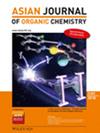具有能识别甲醇的胍基结构的BODIPY和香豆素荧光团组成的高级pH指示剂
IF 2.8
4区 化学
Q1 CHEMISTRY, ORGANIC
引用次数: 0
摘要
胍具有很强的碱性,具有较高的分子识别能力。我们利用胍的强碱性,开发了一种含胍的苯并喹啉,用于MeOH的荧光检测。苯并喹啉荧光团定量检测乙醇中的MeOH,灵敏度中等,检出限(LOD)为16.5%。在这项研究中,我们开发了两个胍基硼二吡啶(BODIPY)和两个胍基香豆素荧光团。这些荧光团具有比苯并喹啉类更高的摩尔消光系数(柱),这表明它们可以提高检测灵敏度。BODIPY荧光团对MeOH表现出酸响应性的开启荧光,类似于苯并喹啉荧光团。它们的高ε值使得MeOH在EtOH中的检测灵敏度提高了1.3%。香豆素衍生物表现出酸反应性关闭荧光。此外,质子化香豆素和中性香豆素的吸光度光谱位移使得MeOH的比例检测成为可能(LOD分别为0.85%和0.57%)。该研究证明了胍基荧光团在分子识别中的应用,并促进了分析化学中类似荧光团的发展。本文章由计算机程序翻译,如有差异,请以英文原文为准。
Advanced pH Indicators Consisting of BODIPY and Coumarin Fluorophores with a Guanidinyl Structure Capable of Methanol Recognition
Guanidine is strongly basic and has a high molecular recognition ability. We previously developed a guanidine‐bearing benzoquinoline for the fluorescence detection of MeOH by exploiting the strong basicity of guanidine. The benzoquinoline fluorophore quantitatively detected MeOH in EtOH with moderate sensitivity and a limit of detection (LOD) of 16.5 %. In this study, we developed two guanidinyl boron dipyrromethene (BODIPY) and two guanidinyl coumarin fluorophores. These fluorophores have higher molar extinction coefficients (ϵ) than those of benzoquinolines, which suggests that they could have improved detection sensitivity. The BODIPY fluorophores exhibited acid‐responsive turn‐on fluorescence for MeOH, similar to the benzoquinoline fluorophore. Their high ϵ values led to an enhanced MeOH detection sensitivity of 1.3 % in EtOH. The coumarin derivatives exhibited acid‐responsive turn‐off fluorescence. In addition, the absorbance spectral shift of the protonated and neutral forms of coumarin enabled the ratiometric detection of MeOH (LOD=0.85 % and 0.57 %, respectively). This study demonstrates the utility of guanidine‐based fluorophores in molecular recognition and promotes the development of similar fluorophores in analytical chemistry.
求助全文
通过发布文献求助,成功后即可免费获取论文全文。
去求助
来源期刊

Asian Journal of Organic Chemistry
CHEMISTRY, ORGANIC-
CiteScore
4.70
自引率
3.70%
发文量
372
期刊介绍:
Organic chemistry is the fundamental science that stands at the heart of chemistry, biology, and materials science. Research in these areas is vigorous and truly international, with three major regions making almost equal contributions: America, Europe and Asia. Asia now has its own top international organic chemistry journal—the Asian Journal of Organic Chemistry (AsianJOC)
The AsianJOC is designed to be a top-ranked international research journal and publishes primary research as well as critical secondary information from authors across the world. The journal covers organic chemistry in its entirety. Authors and readers come from academia, the chemical industry, and government laboratories.
 求助内容:
求助内容: 应助结果提醒方式:
应助结果提醒方式:


